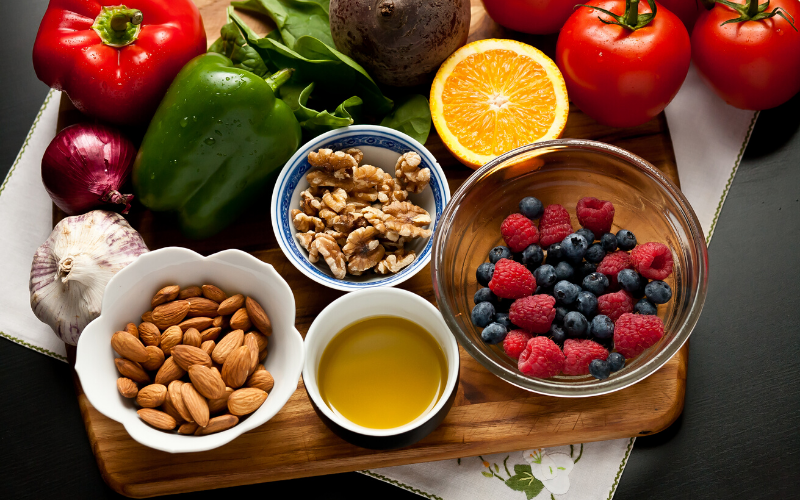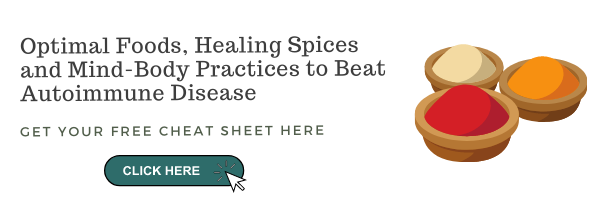Have you heard of the anti-inflammatory diet?
If you’ve read my book, Built to Thrive, you know I’m a huge fan.
Eating with a focus on reducing inflammation is one of the single most important and easiest things you can do to support and improve your health.
But what exactly does it mean to eat an “anti-inflammatory” diet?
While the practice is becoming more mainstream, there’s also still some confusion surrounding this diet and what exactly you should eat if you’re trying to reduce inflammation.
How Does The Anti Inflammatory Diet Work?
First, let’s define inflammation.
Inflammation is the body’s response to an injury or an infection. Blood flows to the injured area, white blood cells work to heal things up, and voila! You feel all better. So, in very small amounts, inflammation can actually be a good thing.
The problem comes in when your body becomes chronically inflamed.
Due to chronic lack of sleep, poor diet, too much stress, or maybe a hormonal imbalance, your body can find itself in a constant loop of inflammatory response. This means your body is always working overtime to try and reduce inflammation in multiple ways and multiple locations.
The result?
You are much more likely to develop disease.
Most chronic health conditions, from heart disease to cancer, have been linked to elevated levels of inflammation. So it’s definitely a situation we want to avoid.
And the standard American diet makes reducing chronic inflammation almost impossible.
Processed and convenience foods, sugars, and simple carbohydrates like bread, muffins, and cereals all tend to increase inflammation. Same for fried and fast foods.
This is where the anti-inflammatory diet shines. Instead of inflammation-promoting foods, it’s full of the foods that have been shown to decrease inflammation.
What Foods Are Included On The Anti Inflammatory Diet?
At this point, you may be wondering what foods are part of the diet…
It may also help you to know that the anti-inflammatory diet is also commonly known as the Mediterranean diet.
Basically, with the anti-inflammatory diet, you’re shooting for eating like some of the healthiest populations in the world.
The people that live the longest and have the least incidence of disease within their population.
There are certainly other factors to their lifestyle that promote health — they tend to move a lot as part of their day (they don’t necessarily kill themselves for hours in the gym). And they also tend to live in tight-knit communities that encourage and lift them up…they regularly de-stress….and they also are likely to attend faith-based services.
But the one thing that ties the healthiest populations in the world together that we can all adopt rather easily is the food they eat.
To eat anti-inflammatory, you need to add in the following foods:
- Vegetables — as many as you can eat
- Fruits
- True whole grains — think oats and barley, not grains that have been made into flour
- Beans and legumes
- Nuts and seeds
- High-quality olive oil
- High-quality Omega-3 fatty acids in foods like wild-caught salmon, flax seeds, and beans
- Occasional servings of other animal protein like chicken, eggs, yogurt or cheese
- Fiber! Our ancestors likely ate 100g of fiber a day — the average American today eats maybe 15 grams.
You also need to reduce the following foods:
- White flour
- Sugar
- Dairy
- Red meat
- Fried food
- Saturated fat
For bonus points, you can add in anti-inflammatory spices like:
- Turmeric
- Ginger
- Garlic
- Cinnamon
Some of my favorite anti-inflammatory foods include:
- Leafy vegetables — kale, greens, spinach, swiss chard
- Berries and apples — these are great sources of fiber and antioxidants
- Extra virgin olive oil — this is the main source of fat in the Mediterranean and it makes vegetables taste amazing. Its positive effects on the heart (especially when combined with veggies) and aging have been well-studied.
- Lentils — these are the ultimate convenience food. You don’t have to soak them and they cook quickly, unlike a lot of beans. They’re packed with fiber and soak up flavors in any dish.
One of the best aspects of eating anti-inflammatory is that it’s not really a restrictive diet like some.
The general idea is to eat mostly plants, and get as much fiber in as you possibly can.
There are no complicated rules or the need to throw out an entire food group. You don’t even have to count calories on this “diet.” The idea here is to focus on packing as much healthy food into your day as you possibly can and then the less desirable, inflammatory options will fall to the wayside as a natural result.
And this diet isn’t expensive to follow. Fresh veggies and beans are definitely less expensive than take out…
A great rule of thumb when eating anti-inflammatory is to cover at least half your plate with veggies, a quarter with whole grains, a quarter with protein (beans or wild-caught fish most often) and drizzle it all with olive oil. It really is that simple.
Eating To Fight Disease
We know that the anti-inflammatory diet is great for health
We know that the healthiest populations in the world eat in this way.
We also know that it’s a rather easy diet to follow for its flexibility and wide array of food options to choose from.
But in what specific ways has it been shown to be “healthy”?
Well, this diet has been clinically shown to reduce the incidence of:
These are some of the most deadly conditions in the world.
If you could change the way you eat and know that you would significantly lower your chance of developing one of these diseases, wouldn’t you?
Need a little more guidance?
Eating this way has become a way of life for me and many of my patients.
But I know it can be challenging and frustrating to try to change your diet and your lifestyle all on your own.
If you’re looking for a little bit more in terms of coaching and guidance, I’m leading a group of fellow change seekers on a mission to revolutionize their health and tap into an endless source of energy.
You can find out more about my newest program HERE.
References
“Mediterranean diet and life expectancy ….”
https://www.ncbi.nlm.nih.gov/pmc/articles/PMC5902736/.
“Why you need olive oil on your salad — ScienceDaily.” 19 May. 2014,
https://www.sciencedaily.com/releases/2014/05/140519160712.htm.
“The Effect of Exclusive Olive Oil Consumption on … – NCBI.” 12 Jan. 2019,
https://www.ncbi.nlm.nih.gov/pmc/articles/PMC6352251/.
“How the Mediterranean diet lowers risk of … – NHLBI – NIH.”
https://www.nhlbi.nih.gov/news/2018/how-mediterranean-diet-lowers-risk-cardiovascular-disease.
“Mediterranean Diet and Diabetes: Prevention and … – NCBI.” 4 Apr. 2014,
https://www.ncbi.nlm.nih.gov/pmc/articles/PMC4011042/.
“Impact of Mediterranean diet on metabolic syndrome … – NCBI.” 24 Nov.
2016, https://www.ncbi.nlm.nih.gov/pmc/articles/PMC5352455/.
“Impact of Mediterranean Diet on Cancer: Focused … – NCBI.” 3 Nov. 2017,
https://www.ncbi.nlm.nih.gov/pmc/articles/PMC6070327/.



